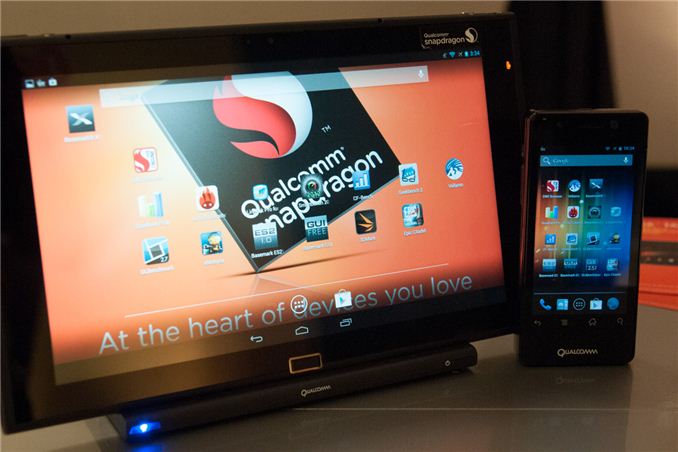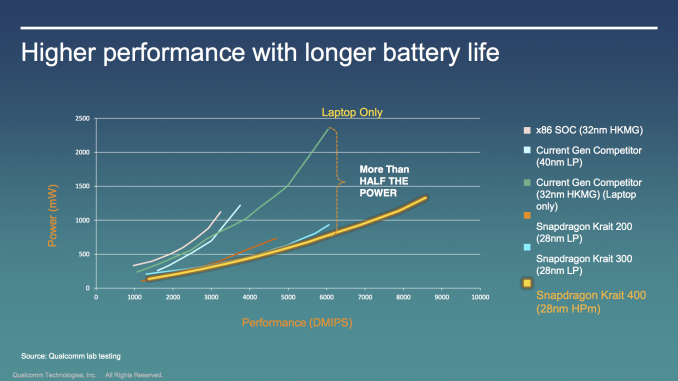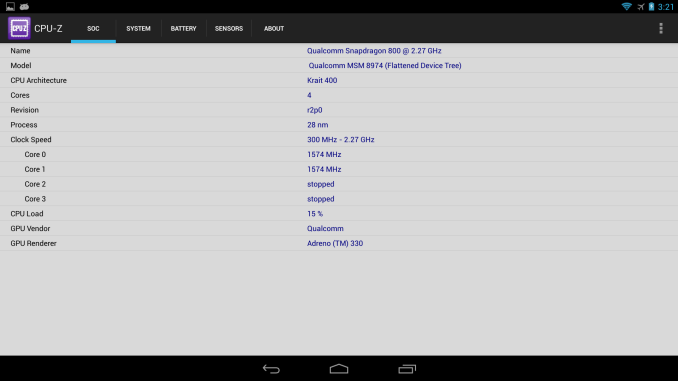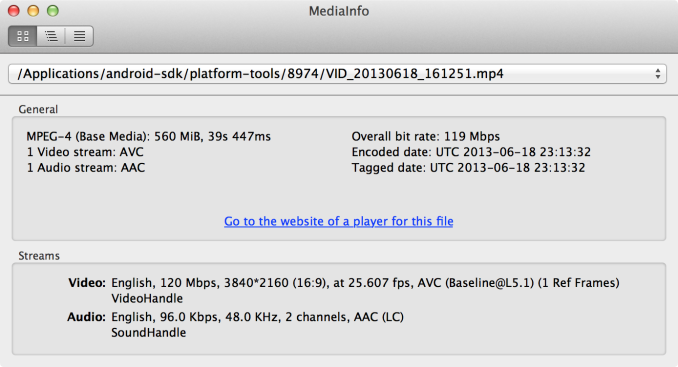Snapdragon 800 (MSM8974) Performance Preview: Qualcomm Mobile Development Tablet Tested
by Brian Klug on June 18, 2013 8:00 PM EST
We’ve written about Snapdragon 800 (MSM8974) before, for those unfamiliar, this is Qualcomm’s new flagship SoC with four Krait 400 CPUs at up to 2.3 GHz, Adreno 330 graphics, and the latest modem IP block with Category 4 LTE. Qualcomm is finally ready to show off MSM8974 performance on final silicon and board support software, and invited us and a few other publications out to San Francisco for a day of benchmarking and poking around. We looked at MSM8974 on both the familiar MSM8974 MDP/T, a development tablet used both by Qualcomm and 3rd parties to develop drivers and platform support, and the MSM8974 MDP phone, both of which have been publicly announced for some time now.
The tablet MDP is what you’d expect, an engineering platform designed for Qualcomm and other third parties to use while developing software support for features. Subjectively it’s thinner and more svelte than the APQ8064 MDP/T we saw last year, but as always OEMs will have the final control over industrial design and what features they choose to expose. Display is 1080p on the tablet and 720p on the phone, a bit low considering the resolutions handset and tablet markers are going for (at least 1080p on phone and WQXGA on tablets) so keep that in mind when looking at on-screen results from benchmarks.
| Qualcomm Snapdragon 800 Mobile Development Platform Tablet | |
| MSM8974 MDP/T | |
| SoC | MSM8974 Snapdragon 800 |
| CPU | 4x Krait 400 at 2.3 GHz |
| GPU | Adreno 330 at 450 MHz |
| RAM | 2GB 2x32 LPDDR3 800 MHz |
| NAND | 32 GB eMMC 4.5 |
| Cameras | 12 MP with flash (rear), 2 MP (front) |
| Display | 11.6-inch 1080p |
| I/O | USB 3.0, microHDMI, microSD, 3.5mm headset |
| OS | Android 4.2 |
Snapdragon 800, nee MSM8974 is built on TSMC’s 28nm HPM (High Performance for Mobile) HK-MG, as opposed to 28nm LP polysilicon (low power). The result are higher clocks for CPU, from 1.5–1.7 GHz on Krait 200–300 which was 28nm LP, to 2.2–2.3 GHz on Krait 400 on 28nm HPM. The jump between Krait 200 and Krait 300 brought higher clocks and also a jump in IPC, this time around Krait 400 is essentially a Krait 300 implemented on 28nm HPM, which means some relayout. There’s also a faster L2 cache on Krait 400.
These are final clocks on MSM8974 – Krait 400 runs its four cores at up to 2.3 GHz, though some lots will come at 2.2 GHz. GPU on MSM8974 is Adreno 330 which runs at 450 MHz and brings some architectural improvements over Adreno 320.
On the video side, MSM8974 is capable of encoding UHD 4K (3840 x 2160) 30 FPS video at up to 120 Mbps H.264 High Profile, and is capable of playing back the same file. Qualcomm had a demo going showing this mirrored on the latest Sony 4K UHD TV as well over microHDMI. I recorded a video sample and took a copy for your perusal and onto YouTube. True to their word the video I grabbed is 120 Mbps and 3840 x 2160, framerate was just over 25 FPS but I'm not sure if the demo was setup for 30 FPS capture. MSM8974 has the hardware encoder for H.264 but not HEVC H.265, that's implemented in software.
Snapdragon 800 should begin popping up in phones and tablets fall 2013. Anyhow let's take a look at MSM8974 performance.

























115 Comments
View All Comments
Wilco1 - Thursday, June 20, 2013 - link
A low clocked single or dual Haswell won't be anywhere close to 4 times faster than a high clocked quad A15/Krait.jeffkro - Wednesday, June 19, 2013 - link
Cool, should make a great chromebook processor.WagonWheelsRX8 - Wednesday, June 19, 2013 - link
Good stuff, always like hardware reviews on Anandtech!Feature Request: When you create the charts, can you include the SoC next to the device name? It's good to know that a Google Nexus 10 is faster than Google Nexus 4, but I think the additional information of the SoC contained within would help chart readability greatly.
Thanks!
Kill16by9TN - Thursday, June 20, 2013 - link
I very much second that, since I was struggling with the very issue, always scrolling up and down in an effort to keep up with which SoC is in which product.MrPhilo - Wednesday, June 19, 2013 - link
Anyone know the reason why the Galaxy S4 (Exynos 5420) GPU performs slower than the iPhone 5 GPU on offscreen test? Even though the GPU is similar but the S4 having a higher clockspeed and higher bandwidth?Cotita - Wednesday, June 19, 2013 - link
I don't think Tegra 4 will be able to compete here. Tegra 5+kepler will be its last chance.Alberto - Wednesday, June 19, 2013 - link
Since performance comes at a cost, this Soc seems in the 8/10 W Tdp range running games. The comparison is pretty clear with A4-5000, done on the same process.Likely the power draw is lower in cpu only tasks but IMO users will enjoy a fast battery death under games. It's a Qualcomm choice, will see the market acceptance.
I prefer more balanced socs, this do not seem the case.
virtual void - Wednesday, June 19, 2013 - link
I will be interesting to see how the Silvermont based SoC stand up against Snapdragon 800 and Tegra 4. I guess it will do quite well considering that CloverTrail+ seem to beat even Exynos 5 Octa. CT+ is a dual core CPU using a 5 year old Atom design...And this is the most interesting part "Intel's chip scores highest on the most tests and draws the least current"
http://www.androidauthority.com/intel-clovertrail-...
I don't feel that today's phone need more CPU-power, they should instead focus on reducing power consumption. But tables can definitely use a lot more CPU-power!!
Wilco1 - Wednesday, June 19, 2013 - link
Exynos Octa beats the current fastest Atoms by a huge margin at a lower clock speed, so don't expect Silvermont to come close to A15: http://browser.primatelabs.com/geekbench2/compare/...That link seems to be an Intel sponsored test without any details how it was done. The benchmark I linked however is known to be independent and doesn't favour either Intel or ARM.
virtual void - Wednesday, June 19, 2013 - link
How does that link seem Intel sponsored? The numbers presented by the analyst firm is just the numbers from Antutu and that has been verified by others (search YouTube for example).If you read the review of the Z2460 & Z2670, then notice that Geekbench is really the only benchmark where those SoC performs bad against ARM SoC used at that time (Tegra 3 was very popular at that point).
If you ever actually used units based on Z2460 or Z2670 (tablets) side by side with units using Tegra 3 running the same OS and application, then you would know that the Atom systems definitely feels faster so I don't really trust Geekbench as a measurement on how things feel.
Cortex A15 is not that far behind Core i5-3320M according to Geekbench, which to anyone that used systems using those CPUs know is kind of ridiculous.
http://browser.primatelabs.com/geekbench2/compare/...
The question one can ask oneself: how come that two benchmarks that are supposed to measure roughly the same attributes of a system get such radically different result? Do you have other benchmarks? The only other benchmarks I can find myself are the web-based ones and they show the Atom in pretty good light.